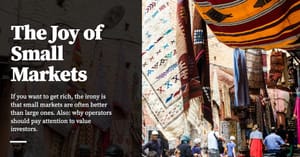During the Commoncog Case Library Alpha, we sent a small group of Commoncog members eight cases on Scale Economies as a competitive advantage. Each case was a self-contained narrative about some business story, designed to demonstrate a particular instantiation of scale economies in the real world. The thesis? As with all things Case Library-related, the goal was to see if we could accelerate business pattern recognition with a sequence of varied case studies.
The cases we covered in the Alpha were:
- Ford - A Car For Everyone — in which we told the story of Henry Ford, who discovered scale economies and learning curve effects somewhat by accident.
- Netflix - Becoming a Large Movie Studio — in which we told the story of Netflix’s pivot to content production, which in one fell swoop turned their scale into a competitive advantage.
- Paypal - Poisoning The competition — in which we told the story of PayPal’s scale advantage in creating better fraud detection models in the early 2000s.
- Texas Instruments - Inventing Learning Curve Pricing — in which we told the story of Morris Chang’s discovery of Learning Curve pricing, and his eventual ouster from TI.
- Koufu - Feeding a Nation — in which we covered scale economies in the context of Singapore’s food court industry.
- Nike - Living in a Variable Expense World — in which we covered Nike’s scale advantage as a function of the structure of the athletic apparel industry (if everyone in your industry spends the same % of sales on marketing, certain marketing benefits accrue to the largest player).
- Amazon - From Books to Everything — in which we explored scale as a necessary property for Amazon’s business model.
- TSMC - Slow Dominance — and to close it off, a return to Morris Chang, who took many of the lessons he learnt in Texas Instruments to their logical conclusion in TSMC.
(If you’d like to browse through all of the cases, as well as read the main concept page, you may do so here.)
A few of these cases we sent were straightforward. A few of them were not. One of the more interesting things to have come out of the alpha was a particular exchange in the forums, where participant kharling pointed out that Learning Curve and Scale Economies were two separate concepts, and that perhaps we should separate the two.
This was a legitimate point!
To summarise a little, scale economies occur when you have high fixed costs, but you then amortise those fixed costs across a large customer base (imagine a milk factory for a leading F&B brand; that leading brand can build and operate a larger factory, amortising the cost across a larger number of distributors). On the other hand, learning economies occur when you reduce production costs the more you produce (imagine semiconductor manufacturing — where the number of manufacturing errors per production line goes down the more chips are produced over time).
In practice, the two concepts tend to show up together, depending on the industry.
To make things more complicated, Wikipedia’s entry for scale economies includes the following definitions:
- Growth Economies occur “when a company acquires an advantage by increasing its size. These economies are due to the presence of some resource or competence that is not fully utilised, or to the existence of specific market positions that create a differential advantage in expanding the size of the firms (emphasis mine)”
- Learning Economies implies “improvements in the ability to perform and promotes the introduction of incremental innovations with a progressive lowering of average costs (… learning economies) are directly proportional to the cumulative production”.
If we want to be precise, the PayPal case and the Nike case are examples of ‘Growth Economies’, while TSMC and TI are examples of ‘Learning Economies’.
Wikipedia’s definitions are two of a whole number of ‘determinants of scale economies’, including things like “greater bargaining power from scale”, “economies in holding stocks and reserves” and “cost-of-capital efficiencies in scaling”.
Which, ok, cool.
My question: how useful are these definitions in practice, really?
I ask this because I tend to be a stickler for rigorous thinking — and one aspect of rigorous thinking means being very precise with definitions. My conundrum is as follows: on the one hand, I need to be precise with my words. On the other … perhaps it isn’t necessary to be this precise when pursuing competitive advantage in practice?
The tension between accuracy and use was what was going through my head when I asked Dr Rand Spiro about our experience a handful of weeks ago. Spiro originated the case library approach we were using, amongst other things; I talked about a different aspect of our conversation in last week’s piece. Our conversation went as follows:
Me: What was difficult (for me) was the borderline cases. One of the cases we examined was the story of Nike, and in Nike, the scale economies instantiation was this weird thing where it isn’t really production costs per unit going down with scale. It was that someone — an equity research analyst — went and checked the numbers of all these public athletic apparel companies and found out that every single one of these companies spent 10-12% of their revenue on marketing. It was weirdly consistent across all the companies — didn’t matter if it was Nike (which was the largest) or Adidas, Puma, Under Armor, or whatever, and the equity research analyst concluded that if this were the case, then Nike has a bit of a built-in advantage because of its size. After all, 10-12% of the largest amount of revenue is a huge amount for marketing! And it’s almost like a law of physics (in that it applied to everyone in the industry). So we wrote this, and people were like “yeah, but is that really scale economies?”
Spiro: Well, ok, a number of thoughts about that. Just the language of what you said — is this ‘really’ scale economies, and you mentioned earlier, blurring the boundaries, stretching the boundaries and so on. That’s where you get into the ill-structuredness (of reality), and where you want to blur the boundaries — in a sense, the more you stretch it, the more the use becomes metaphorical or analogical.
So, is there a ‘real’ economies of scale? No, of course there isn’t a real economies of scale! Economies of scale is a concept that was made up. It’s applied in some ways (to some cases) that are very similar to other (cases), but other (cases) are things that are ‘economies of scale’-like, or ‘economies of scale’-ish.
And so it’s helpful to think of this in the case of Nike — you know, a higher amount of advertising because they’re (spending) 10-12% of a large number. Is that economies of scale or just scale? It doesn’t really matter. It is what it is. If you try to pigeonhole it into economies of scale or not economies of scale, you miss the Nike case, the actual Nike case and (the) reality with its advertising, with some aspects of economies of scale, and other things that are just scale, but whatever it is, it’s not about do you pigeonhole this under the concept of economies of scale? It’s what’s going on with Nike that didn’t go on with the other companies (emphasis added).
A key principle is that the reality comes first, and concepts are used to help you understand reality, not the other way around. For too long, we’ve had concepts at the top, and then cases that illustrated the concept. “‘Economies of scale’, here’s an example, here’s another example.” And then you discard the cases. In a messy, ill-structured, real world, it’s reversed! It’s the case that’s on top, and each case has different concepts.
So the Nike case … economies of scale helps you understand it, and other things help you understand it, but the key thing is the Nike case, not whether you put it here conceptually, or put it over there, conceptually.
Me: One of the things that we noticed in the Alpha test is that we can actually trace the origins of certain concepts. So, for example, in our Texas Instruments case, the very term ‘learning economies’ was created by the Boston Consulting Group consultants who observed Morris Chang creating learning curve pricing. And so it does seem that we have this messy reality, and then people lift it up into concrete concepts, in order to create buckets to categorise messy reality.
Spiro: But then these prototypes become blinders — they form biased lenses that leave out too much in the same way those schemas* I was complaining about before do. It’s as bad to rely on a prototype example because it becomes a magnet that pulls away all the real world variation!
*(For context, Dr Spiro came up with Cognitive Flexibility Theory in response to schema-based theories of expertise, which advanced this view of experts as being experts because they were able to pattern match against schemas they’d built up in their heads. This was the primary view of expertise circa the late 1980s, and the primary view of expertise associated with chess players — which were early subjects of study in the field of expertise research).
In retrospect, my conversation with Spiro revealed that whatever tension I felt around accuracy vs use to be a wonkish thing — specific to me — more than anything else. To put this differently: in the context of this blog, I am a writer, and a writer necessarily fusses over definitions. But as a business practitioner, strict definitions don’t matter as much. What matters are the internalised analogies that you can draw from when it comes time to put things to practice.
I’m not sure how to square this circle — I’m going to continue writing cases and building out the case library, which means that I’m going to keep bumping up against instances of ‘accuracy vs use’. But in practice, if you’re consuming the case library to accelerate your business expertise, then I think it really shouldn’t matter. We know this is true because reality is messy and not amenable to neat definitions; with this piece, we also have it from the horse’s mouth.
Originally published , last updated .
This article is part of the Expertise Acceleration topic cluster. Read more from this topic here→





